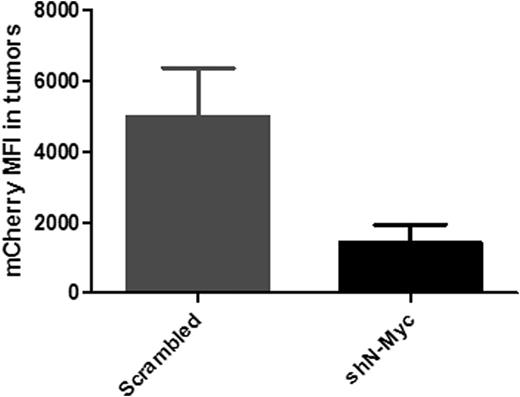Abstract
Early T-cell precursor–ALL (ETP-ALL) is a subtype of T-cell acute lymphoblastic leukemia that displays both myeloid and lymphoid phenotypic features and has a relatively poor prognosis. Our previous work has shown that activating mutations in the Il7 receptor (Il7r) and Lmo2 overexpression in CD4-CD8- thymocytes cause ETP-ALL in mice via DN2 thymocyte differentiation block. To further understand the molecular mechanisms responsible for initiation and maintenance of ETP-ALL, we compared expression profiles of seven murine ETP leukemias induced by Lmo2 and Il7r mutant vectors and four preleukemic blocked DN2 Arf-/- thymocyte populations to normal murine DN2 Arf-/- thymocytes. This analysis and qRT-PCR identified N-Myc as one of the top upregulated genes in either Lmo2 or Il7r mutant samples. Importantly in pediatric ETP-ALL N-Myc RNA is expressed at high levels in 11/13 human cases compared to 26/72 T-ALL cases corroborating our murine model with the human disease. To investigate if N-Myc itself was sufficient to induce ETP leukemia, immature murine Arf-/- thymocytes were transduced with a retroviral vector expressing the N-Myc cDNA and YFP. After 20 days in culture a block at the DN2 stage of thymocyte development was observed that recapitulated the Lmo2 and the Il7r receptor mutant phenotype. When sublethally irradiated Rag2-/-, γc-/- recipient mice were transplanted with N-Myc transduced Arf-/- thymocytes 5/5 of the primary recipients developed ETP leukemia originating from the thymocyte graft with a median latency of 60 days (Figure 1). These mice had elevated white blood cell counts between 17-85x103/µl and enlarged spleens ranging in weight from 0.42g-0.67g. Flow cytometry analysis showed that their spleen, thymus and peripheral blood contained greater than 70% YFP+ Gr1+ cells. These N-Myc induced leukemias expressed both T-cell (cytoplasmic CD3) and myeloid (Gr1 and Mac1) markers and displayed other features typical of ETP disease. Having established that N-Myc is sufficient to initiate ETP leukemia in the murine model, we next tested if N-Myc is critical in the maintenance of ETP leukemia induced by Il7r mutants. ETP leukemic cells arising from the Il7r 241-242TC mutant were transduced with a mir30 lentiviral vector that contains a short hairpin N-Myc inhibiting sequence and mCherry as a reporter gene (shN-Myc). This vector has been shown to reduce N-Myc mRNA levels by five fold in N-Myc overexpressing cells. The transduced cells were analyzed and sorted for leukemic+ (GFP) scrambled+ (mCherry) or leukemic+(GFP) shN-Myc+(mCherry) double positive cells. Analysis of the cells showed the mCherry mean fluorescence intensity (MFI) of the leukemic cells transduced with shN-Myc was approximately double that of the scrambled transduced cells, demonstrating at least equal transduction efficiency of the two vectors. Sorted double positive leukemic cells were transplanted into sublethally irradiated WT recipients. All animals succumbed to leukemia and were subsequently analyzed by flow cytometry for expression of scrambled and shN-Myc vector expression. Analysis of tumor cells showed a significant decrease in the mCherry expression of the cells containing the shN-Myc compared to the scrambled control indicating that sustained N-Myc expression is selected for during the maintenance of ETP leukemia and in the future a tetracycline control element will be incorporated into the shN-Myc to confirm this (Figure 2). Furthermore we plan to test therapeutics against N-Myc such as bromodomain and Aurora kinase A inhibitors in vitro and plan to expand this in vivo. This demonstrates the utility of this novel mouse model combined with gene expression profiling to elucidate the signaling networks in ETP leukemia to develop targeted therapy for this aggressive disease.Close modalClose modal
Figure 1
Survival curve of recipient mice transplanted with CD4-CD8- thymocytes transduced with N-Myc and Il7r mutants.
Figure 1
Survival curve of recipient mice transplanted with CD4-CD8- thymocytes transduced with N-Myc and Il7r mutants.
Figure 2
Mean fluorescent intensity (MFI) of mCherry in mice transplanted with leukemic+ (GFP) Scrambled+(mCherry) or leukemic+(GFP) shN-Myc+(mCherry) double positive cells.
Figure 2
Mean fluorescent intensity (MFI) of mCherry in mice transplanted with leukemic+ (GFP) Scrambled+(mCherry) or leukemic+(GFP) shN-Myc+(mCherry) double positive cells.
Disclosures:
No relevant conflicts of interest to declare.
Author notes
*
Asterisk with author names denotes non-ASH members.
© 2013 by The American Society of Hematology
2013



This feature is available to Subscribers Only
Sign In or Create an Account Close Modal